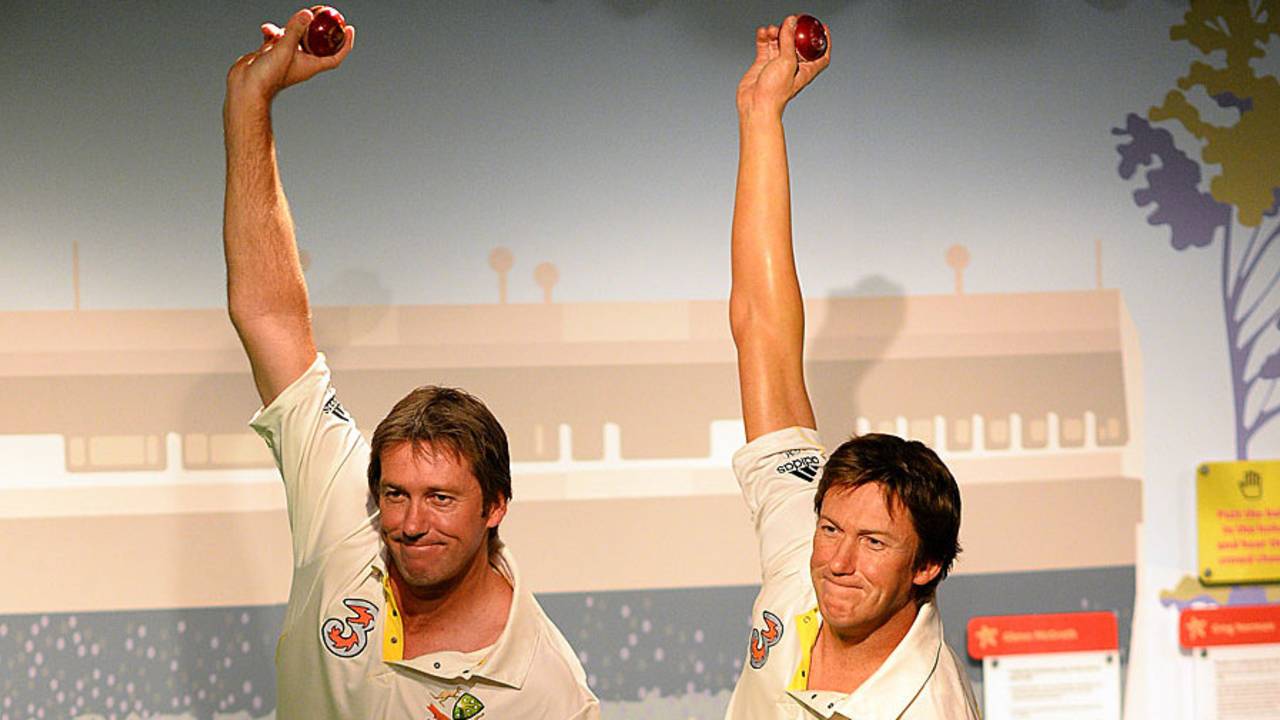When McGrath bowled the perfect over
Nasser Hussain was the hapless victim when McGrath bowled six flawless deliveries at the Gabba in 2002
Vijay Subramanya
14-Oct-2015
Was this wax statue of Glenn McGrath as accurate as his bowling? • AFP
It was Aristotle, who in Metaphysics, wrote, "The whole is greater than the sum of its parts". More than 23 centuries later, it was Glenn McGrath, who, over the course of six balls, gave one of the best illustrations of the idea on a cricket field. By any measure, the parts, the individual deliveries, were unremarkable: none of them were comparable to Shane Warne's Gatting ball or Wasim Akram's double-swing miracle. But the whole, the over, was a poem whose brilliance transcended the beauty of its lines. And as Nasser Hussain trudged off at the end of it, he must have glimpsed his chances of winning the 2002-03 Ashes melting away in the Brisbane sun.
That McGrath was accurate is well-known. In case there is doubt, this over provides a conclusive validation, as Hawk-Eye would attest. However, saying McGrath's effectiveness lay solely in his accuracy is like saying Warne's magic could be attributed to his ability to generate sharp turn alone. Of course, turning it square was crucial for Warne, but so were his drift and variations in flight and pace. Similarly, McGrath's subtle lateral movement and extra bounce, combined with his consistency, allowed him to execute a plan like a computer. It is precisely this ability of McGrath's that elevated the his over to Hussain to greatness.
The scene is a late November afternoon at the Gabba. Chasing an improbable 464 against the Australian attack, England had suffered an early setback, losing the openers within the first two overs. Hussain joined Mark Butcher and the duo's concern was survival, at least till stumps on the fourth day. As their stand grew stubborn, Waugh brought back McGrath for his second spell.
McGrath began the over with a good-length delivery on the fifth stump and moving in off the seam. Hussain shouldered arms. McGrath figured it was time for the good old, tried and tested formula: Get the batsman to leave a few innocuous balls before bringing one in off the seam to sneak through his defence. And so, the second ball mimicked the first but held its line. Hussain let it go. The next one pitched on the exact same spot, hardly deviated but bounced slightly higher. Hussain saw it through to the keeper. Fourth ball, same story. Hussain looked assured and must have thought he had it figured out. At least Tony Greig did, who remarked on air, "Hussain here... has got a pretty good idea where his off stump is at the moment."
The set-up was now in motion. The first act was done and the bluff was around the corner. But Hussain, who had seen Vaughan fall for it earlier, knew the strategy. He just needed to watch closely and play anything that threatened to jag back in. The fifth ball was fuller, but it followed its predecessors' path and Hussain did not care to disturb it.
The sixth ball of the over. Both the bowler and the batsman knew what usually came next. Hussain saw McGrath's delivery stride go a half-foot wider of the crease to generate the angle. He saw the ball land on the fourth stump, closer than the previous deliveries. Seeing that it had followed the script so far, he decided to put bat on ball. However, little did he know that McGrath was a step ahead of the script. Instead of targeting the pads, the ball moved away, lured the bat to follow it and took the edge. Ponting, at second slip, did the rest.
Thus ended Hussain's nightmarish Test. Deciding to bowl first on a belter of a track, seeing his fielders drop dollies, conceding 364 for 2 on the first day and losing Simon Jones to a horrific injury, Hussain was perhaps relieved to get back to the dressing room. However, he still had to bear England's capitulation as they collapsed to 79 all out.
Test matches are won by bowlers and Hussain had seen the genius of the opponent's strike bowler first-hand. What chance did England have! George Bernard Shaw once derided cricket as a game played by 11 fools. Had he witnessed those six balls, perhaps he would have reduced the number to ten.
Do you have any thoughts on 'The Perfect Over'? You could send your articles to us here, with "Inbox" in the subject line.
Vijay Subramanya is a grad student in computer science. He hopes his blog, which has begun cautiously, flourishes soon, like a Mahela Jayawardene innings.
